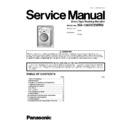Panasonic NA-106VC5WRU Service Manual ▷ View online
NA-106VC5WRU
29
11.5. Electronic Pressure Sensor (EPS)
Electromagnetic field occurs due to movement of pressur-
ized membrane. The spring moves vertically by nucleus
due to electromagnetic field. The water level is regulated
according to the frequency changes of the spring by elec-
tronic card.
ized membrane. The spring moves vertically by nucleus
due to electromagnetic field. The water level is regulated
according to the frequency changes of the spring by elec-
tronic card.
Testing component
Push the door lock slider with screwdriver.
Select the 1st program and start the machine.
Unplug power cable when as soon as water intake finishes
and drum begins to rotate.
and drum begins to rotate.
Check the water level inside the drum with ruler. It should
be 10 cm ±1.
be 10 cm ±1.
NA-106VC5WRU
30
11.6. Motor
The washing machine has an asynchronous motor. It is
controlled by the PCB. It is essential to check the motor for
correct diagnosis and quick servicing. In the below picture,
socket points on the motor is shown to measure with multi-
meter.
controlled by the PCB. It is essential to check the motor for
correct diagnosis and quick servicing. In the below picture,
socket points on the motor is shown to measure with multi-
meter.
Motor socket terminals
Testing components
Tacho resistance control
Check the motor tacho terminals on the motor socket with
multimeter as shown in the picture above.
multimeter as shown in the picture above.
You can determine the ohm value by measuring from the
pink cable at 16th and red cable at 6th position in the large
socket (refer to section 12 Wiring Connection Diagram) as
shown on right figure. For resistance values, refer to the
table below.
pink cable at 16th and red cable at 6th position in the large
socket (refer to section 12 Wiring Connection Diagram) as
shown on right figure. For resistance values, refer to the
table below.
Stator Resistance Control
Check the motor stator terminals on the motor socket with
multimeter as shown in the picture.
multimeter as shown in the picture.
You can determine the ohm value by measuring from the
black cable at 18th and brown cable at 8th position in the
large socket (refer to section 12 Wiring Connection Dia-
gram) as shown on right figure. For resistance values,
refer to the table below.
black cable at 18th and brown cable at 8th position in the
large socket (refer to section 12 Wiring Connection Dia-
gram) as shown on right figure. For resistance values,
refer to the table below.
Tacho and stator resistance values of motor:
NA-106VC5WRU
31
11.7. Door Lock
Door lock is activated at the beginning of the program in
order to prevent the door from opening. Locking is gener-
ated by supplying power to PTC-bimetal, after max 6sec
(220V), the bimetal will be warm and ready to close the
contacts. Thus the first impulse to the solenoid will allow
the contact to close and consequently the slider will be
locked by the pin of the sliderlock. The second impulse
causes no electrical and mechanical modifications. It can
be unlocked by the third impulse; the contact is opened
even if the PTC-bimetal remains energized.
order to prevent the door from opening. Locking is gener-
ated by supplying power to PTC-bimetal, after max 6sec
(220V), the bimetal will be warm and ready to close the
contacts. Thus the first impulse to the solenoid will allow
the contact to close and consequently the slider will be
locked by the pin of the sliderlock. The second impulse
causes no electrical and mechanical modifications. It can
be unlocked by the third impulse; the contact is opened
even if the PTC-bimetal remains energized.
Emergency Opening System (PTC-Bimetal) In
Case of Lack of Electric Energy
Case of Lack of Electric Energy
• In case of lack of electric energy during a washing cycle, the
PTC-bimetal assembly will cool down and after minimum 60
sec (considering previous power supply of 30 sec min and
T=20
sec (considering previous power supply of 30 sec min and
T=20
°C) the door will be unlocked and thus can be opened.
• In case the door is closed when current comes back, the
PTC-bimetal assembly will heat again, the slider lock will
lock, the contact will close and the program will continue
from where it stopped.
lock, the contact will close and the program will continue
from where it stopped.
Technical features
Nominal voltage 250 V
Testing component
Check the resistance value on the component with multi-meter as shown in below figures. Resistance value on the (PTC over-
load + solenoid) should be 240
Ω ±20% at 25 °C. That resistance value can be measured from terminal 3-4 (refer to section12
Wiring Connection Diagram).
This socket shows the connection between terminal 3-4 (See wiring diagram below). The resistance read from terminal 3-4 is the
resistance of PTC overload plus resistance of solenoid.
Component test
NA-106VC5WRU
32
12 Wiring Diagram
12.1. Wiring Diagram (Board)
Click on the first or last page to see other NA-106VC5WRU service manuals if exist.

